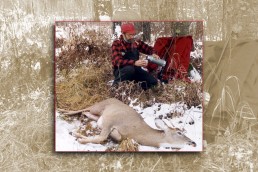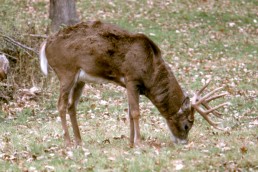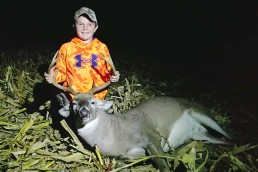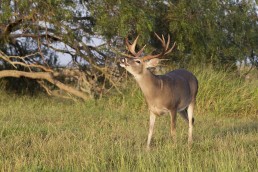A Most Vulnerable Whitetail part two
SHARE THIS POST
Yearlings in the sights
Hunting for whitetail deer is one of the most exhilarating of outdoor pursuits. A yearling buck or doe is one of the easiest whitetails to bring home for many reasons.
If a whitetail fawn loses its mother during a hunting season, it’s doomed. It doesn’t yet know which browse provides adequate nutrition to survive the coming winter. It doesn’t know a thing about migrating to wintering areas where an entire deer herd finds food, cover from wind and snow, and protection from predators via the many highly alert whitetail eyes, noses and ears. Instead, it ends up at the bottom of the local whitetail pecking order. It’s always chased away by other deer, including other fawns, while attempting to feed or bed among them. Motherless fawns are not adopted by other does. While cared for by its mature mother, the fawn is just as elusive. It’s by no means the most vulnerable of whitetails to hunting by humans. That dubious honor belongs to yearling bucks and does.
Yearlings–the most vulnerable of all deer
Yearling bucks and does spend most of their time with their mothers. They learn the tactics they need to survive in the wilds on their own. Young whitetails are good at learning. Their nature makes them eager to imitate their experienced mothers and other mature whitetails. They still depend on their mothers for leadership and direction, however, especially when confronted by danger. As their second fall begins, they spend more and more time away from their mothers. Occasionally, they even explore territories outside the perimeters of their mothers’ ranges. Untried at spotting, identifying and keeping safe distances away from predators and hunters on their own, they experience two early consequences of their growing independence. First, they panic when they discover nearby predators or hunters. Second, they have an unbridled curiosity upon detecting an unfamiliar object, sound or odor. These handicaps make yearlings the most vulnerable of whitetails to human hunters.
Yearling bucks are the most-seen antlered bucks during hunting seasons. They are alone more than does are. Plus, they are not yet skilled at identifying hunters on the ground or up in trees. Their mothers have been teaching them by example to react with little or no alarm, perhaps only freezing in cover upon spotting a human or wolf passing non-stop at a moderate pace with its head pointed straight ahead and obviously not hunting. Their mothers also taught them to react with great, but controlled, alarm upon spotting a nearby human or wolf that is sneaking nearby and halting often to peer about and listen. It’s obviously hunting.
Yearling mistakes make them into steaks
Yearling bucks have also been taught to react with controlled, silent alarm upon spotting a hunter perched in a nearby tree. All of this is a confusing set of evasive actions for an immature yearling to master. To become a regularly successful survivor, it needs experience, sometimes even a brush with death. One that survives one or more harrowing encounters with hunters is likely to react with panic, making a reckless and noisy beeline back to its mother. Along the way, it likely forgets taking the precaution to veer into the wind as quickly as possible to be able to smell and avoid wolves or hunters ahead. Older whitetails routinely do this when fleeing danger, but it’s a fairly common yearling mistake.
Curiosity killed the buck
Sooner or later, a yearling’s unbridled curiosity leads it into perilous straits. Take a fork-horned yearling buck I came to know rather well nearly 50 years ago. This deer couldn’t quit being curious about the potent odor of the fox urine I experimented with as a cover scent. Three mornings in a row, this yearling followed my freshly made scent trail to the base of the tree where I comfortably sat above in my climbing portable tree stand. The buck I had hoped to see there was a big dominant breeding buck that rested in its bedding area about 200 yards away after the exhausting primary breeding phase of the rut. I fully expected to see it during whitetail feeding hours, following the tracks of the doe and fawn that daily browsed on red osiers along the crest of a low ridge that ranged deep into an adjacent alder swamp.
It was amusing to observe the obvious consternation of the yearling buck each time it circled my tree. I could imagine it wondering if I had sprouted wings and flown away. No trail laced with stinky fox urine led away from the site. After spending about 15 minutes scanning its surroundings from beneath my tree, it would finally swish its tail and wander off in the direction taken by the doe and fawn.
Are you enjoying this post?
You can be among the first to get the latest info on where to go, what to use and how to use it!
Buck back again
On the third morning, the last day of the hunting season, the young buck showed up again. It was marching directly toward me as if determined to at last solve the mystery of the disappearing hunter. After rounding my tree a few times and anxiously scanning its surroundings again, it wandered away in a different direction, occasionally halting to turn and stare back towards my tree. About 15 minutes later, it disappeared into a dense patch of second-growth aspens. Shortly, I heard rapid hoof beats. The buck was returning. About 40 yards away, it suddenly froze, its eyes pointed directly at me, likely having spotted me turn my head. For endless minutes I didn’t move, not even blinking.
Then, the deer stomped a fore hoof on the frozen ground and snorted once. That’s a common yearling trick intended to make a suspicious object move to determine whether or not it is something alive. I didn’t move. Following a few more stomps, it suddenly turned and bounded back into the aspens. Thinking this might be a yearling trick I’d seen before to get me to move, I didn’t fall for it. Five minutes later, it cautiously stalked back along its now well-trampled trail and halted about 30 yards away. After staring at me for an additional five minutes, it apparently decided at last I was merely a harmless part of the tree and began contentedly browsing on red osiers. Within a minute, however, it abruptly raised its tail and stood transfixed, this time staring at a porcupine backed up against the upturned roots of a fallen tree.
Hunting made all too easy
“What next?” I wondered, not shaking my head.
With morning drawing to a close I started to assess the whole situation.
“That big dominant buck isn’t going to show up again,” I thought. “A bird in hand is worth two in the bush and I probably shouldn’t ignore this last opportunity of the year to take an antlered buck. A warming cup of hot coffee would be good about now.”
One shot from my 7mm magnum took care of all that.
Author notes:
Dr. Ken Nordberg has written more than 700 magazine articles and 12 books on the habits and hunting of whitetails and black bears, including the “Whitetail Hunter’s Almanac” series. He also produced “Doc’s Buck and Bear Hunting School” videos. His encyclopedic website with whitetail hunting tips is at drnordbergondeerhunting.com and his blog is at drnordbergondeerhunting.wordpress.com. Check out his Twitter page @DrNordberg and his presentations at youtube.com/Dr. Ken Nordberg.
MWO
SHARE THIS POST
Did you enjoy this post?
You can be among the first to get the latest info on where to go, what to use and how to use it!
Dr. Ken Nordberg
Based on his 55 years of field research, Dr. Ken Nordberg has written more than 800 magazine articles, 12 books on whitetails—including the famous Whitetail Hunter’s Almanac series—five books on black bear hunting and produced Buck and Bear Hunting School videos. You may peruse his encyclopedic website with whitetail hunting tips: drnordbergondeerhunting.com, his blog: drnordbergondeerhunting.wordpress.com, or social media pages.



